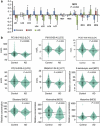Metabolome in progression to Alzheimer's disease
- PMID: 22832349
- PMCID: PMC3309497
- DOI: 10.1038/tp.2011.55
Metabolome in progression to Alzheimer's disease
Abstract
Mild cognitive impairment (MCI) is considered as a transition phase between normal aging and Alzheimer's disease (AD). MCI confers an increased risk of developing AD, although the state is heterogeneous with several possible outcomes, including even improvement back to normal cognition. We sought to determine the serum metabolomic profiles associated with progression to and diagnosis of AD in a prospective study. At the baseline assessment, the subjects enrolled in the study were classified into three diagnostic groups: healthy controls (n=46), MCI (n=143) and AD (n=47). Among the MCI subjects, 52 progressed to AD in the follow-up. Comprehensive metabolomics approach was applied to analyze baseline serum samples and to associate the metabolite profiles with the diagnosis at baseline and in the follow-up. At baseline, AD patients were characterized by diminished ether phospholipids, phosphatidylcholines, sphingomyelins and sterols. A molecular signature comprising three metabolites was identified, which was predictive of progression to AD in the follow-up. The major contributor to the predictive model was 2,4-dihydroxybutanoic acid, which was upregulated in AD progressors (P=0.0048), indicating potential involvement of hypoxia in the early AD pathogenesis. This was supported by the pathway analysis of metabolomics data, which identified upregulation of pentose phosphate pathway in patients who later progressed to AD. Together, our findings primarily implicate hypoxia, oxidative stress, as well as membrane lipid remodeling in progression to AD. Establishment of pathogenic relevance of predictive biomarkers such as ours may not only facilitate early diagnosis, but may also help identify new therapeutic avenues.
Figures


References
-
- Qiu C, De Ronchi D, Fratiglioni L. The epidemiology of the dementias: an update. Curr Opin Psychiatry. 2007;20:380–385. - PubMed
-
- Petersen RC. Mild cognitive impairment as a diagnostic entity. J Intern Med. 2004;256:183–194. - PubMed
-
- Petersen RC, Stevens JC, Ganguli M, Tangalos EG, Cummings JL, DeKosky ST. Practice parameter: early detection of dementia: mild cognitive impairment (an evidence-based review). Report of the Quality Standards Subcommittee of the American Academy of Neurology. Neurology. 2001;56:1133–1142. - PubMed
-
- Gauthier S, Reisberg B, Zaudig M, Petersen RC, Ritchie K, Broich K, et al. Mild cognitive impairment. Lancet. 2006;367:1262–1270. - PubMed
-
- Ray S, Britschgi M, Herbert C, Takeda-Uchimura Y, Boxer A, Blennow K, et al. Classification and prediction of clinical Alzheimer's diagnosis based on plasma signaling proteins. Nat Med. 2007;13:1359–1362. - PubMed
Publication types
MeSH terms
Substances
LinkOut - more resources
Full Text Sources
Other Literature Sources
Medical

